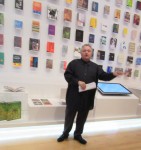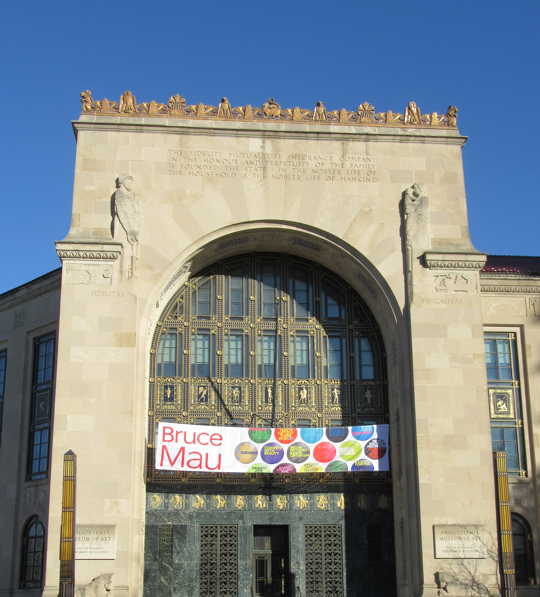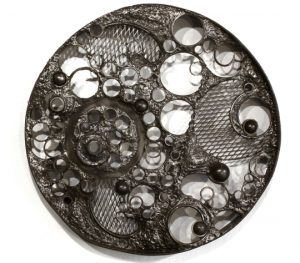Bruce Mau doesn’t want to live in a world where the racial and economic boundaries determine a person’s future. What is the number one predictor of SAT scores for students? Zip code, he said. Mau set out to change the prospects for members of the human race.
“Don’t watch the news” he told a group previewing his exhibit that opens Saturday, Nov. 21, at the Philadelphia Museum of Art. He explained that one might get discouraged listening to reports of wars and violence, but that the human race has never had a better chance of improving its entire lot. There are more educated and affluent people than in the history of the world, and what is needed are the tools to support aspirations.
Over many years of design, Mau put together rules used to create systemic change. One exhibit wall lists each rule, but as Mau said, you have to apply the rule to understand it. “Don’t be cool” is one of those 43 rules. His Rule 15, “Ask stupid questions,” put the audience at ease.
Applying the rule is what Mau brought to Arizona State University. Yes, you can learn mathematics, physics, and astronomy. If you really want to teach and learn, purposeful learning motivates and creates a new learning milieu. So if a student enters saying that they want to travel in space, all of the details of math, physics and astronomy will be gobbled up in the mission.
Michael Crow became president of Arizona State University in 2002. He recognized that the current university model was upside down. Access needed to be increased. He brought in Mau to set it right. Now all employees of Starbucks can get credits toward an undergraduate degree at ASU.
The exhibit, “Work on What You Love,” shows 11 projects over Mau’s career. Although Mau didn’t want to have a retrospective, the display of 11 of his projects gives insight to a global thinker and doer. He worked with the countries of Guatemala and Panama to produce works that would help each country tell the story of who they are and visualize where they are going.
He describes his career: "Who is Bruce Mau? Have you seen Bruce Mau? Get me Bruce Mau. Get me someone like Bruce Mau. Who is Bruce Mau?"
Mau is fearlessly reinventing himself. His current project is unfolding at the exhibit itself. The Personal BlackBox “gives people ownership, security and control of their personal data.” Consumers' preferences are being collected with every purchase, every mouse click. The PBB is a trust that collects and protects the data of its members.
The mechanism of collection will be used at the exhibit itself. Visitors will be able to see an analysis of what parts of the exhibit they paid the most attention to. When applied to the larger world, the individual will have access to his own information, not a third party who sells it. “Imagine seeing yourself in your personal digital mirror and managing your data to reflect yourself more accurately.”

The unifying concept of Mau’s work is that doing what you love will have a good end result. Throughout his career, he sought collaborators who would help him implement his dreams. Rule 23 “Stand on someone’s shoulders. You can travel farther carried on the accomplishment of those who came before you. And the view is so much better.”

Mau never finished college, but has educated himself with his projects. The first wall of the exhibit displays 200 of the books he designed. He put three copies of each book in his personal archive for his children. The first wall is his daughter’s collection. Collaboration with the authors was an education, one which led to a project with architect Frank Gerhy. Rule 1 “Allow events to change you.” The rule might be changed to “Allow an exhibit to change you.”
The exhibit is in the Perelman Building located across the street from the Philadelphia Museum of Art. Mau will be running workshops during the run of the exhibit Nov. 21, through to April 3, 2016. For details visit http://philamuseum.org/brucemau and click the “Workshops” tab.
About Emily Myers
Emily Myers has lived and worked in Chadds Ford for over thirty five years. She founded the parent company of Chadds Ford Live, Decision Design Research, Inc., in 1982. ChaddsFordLive.com represents the confluence of Myers' long time, deep involvement in technology and community. Myers was a founding member of the Chadds Ford Business Association and currently serves on its board of directors. Her hobbies include bridge, golf, photography and Tai Chi. She lives with her husband, Jim Lebedda, in Chadds Ford Township.
- Web |
- More Posts(96)




Comments